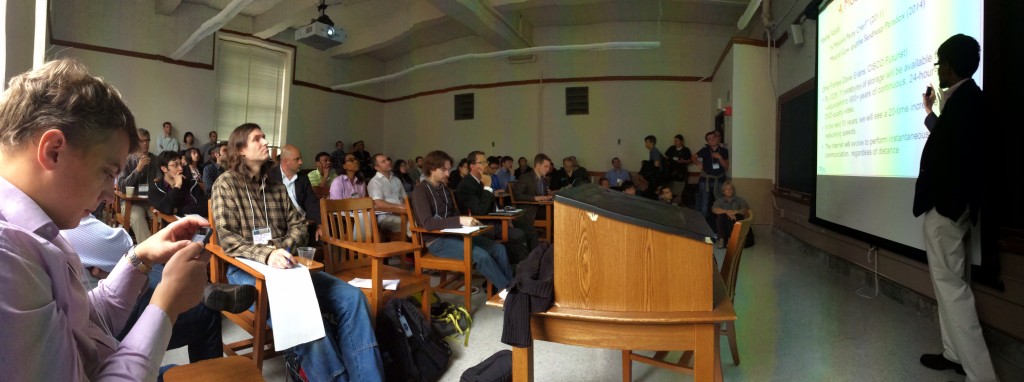The 10th annual Robotics Science and Systems conference is on at the University of California, Berkeley, July 12 to 16. From a small start, the conference now has over 800 attendees, with 28 different weekend workshops this year, and a single track 3 day conference. As well as the latest robotics science, RSS 2014 showcased social, ethical & economic issues in robotics, and highlighted robotics startup stories in some very well attended sessions.
One of the most crowded workshops was the “Next-Generation Robotics: Academia, Start-ups and Industry” session organized by Sachin Chitta, SRI International; Ioan Sucan, Google and Torsten Kroeger, Google. Opening with a plenary from Vijay Kumar, U Penn, the morning session asked industry experts from different domains including automation, manufacturing, automobile, aerospace, healthcare to talk about the next-generation of problems for robotics to address. They talked about the need for new types of robots and capabilities, the research directions that academia could take and the potential for greater industry-academic collaboration.
In the afternoon session, founders and other members from start-ups in Robotics talked about their experience in creating start-ups and bringing new technology to the market, the opportunities for new companies to emerge in the field and the lessons learned. Workshop speakers were; Erik Nieves, Yaskawa; Rainer Bischoff, KUKA Laboratories GmBH; Phil Freeman, Boeing; Murad Kurwa, Flextronics; Paul Millman, Intuitive Surgical; Hanns Tappeiner, Anki; Jim Ostrowski, Blue River Technologies; Matt Williamson, Rethink Robotics; Chris Anderson, 3D Robotics; Steve Lavalle, Oculus; and Joe Romano, Kiva Systems. [see part 2 post for the industry perspective]
Lessons learned by startups
Hanns Tappeiner of Anki says that “every day is demo day”. The last 2 years have been a process of working out the difference between a lab project and making a consumer product. Consumer products have to work every day, all day and you have to be able to make thousands and thousands of them.
Anki launched in October 23 2013 with a hard launch – product in every Apple Store in the US. Their production lines were making thousands a day. Since then, more than 83 million laps have been driven, meaning that Anki cars have travelled 10x round the world or beyond the moon. The company has crossed the trillion planner states mark.
Tappeiner says, “The scary thing about a robotics product is releasing it into the wild.” Other consumer products are less dependent on the tight integration of hardware and software, whereas a robotic product, like an Anki drive car, is very intolerant to variation. 1 gm of weight in the wrong place and it won’t drive well.
It’s also very important to have a fast build/test/iterate cycle. If you take more than a couple of years, then the hardware/software environment has changed too much. For example, Anki were using BLE before it became wide spread and incorporated Zigbee into their design in response to Apple adopting it. The 7 main lessons Anki learned were:
- Find a hungry hardware manufacturer who cares about your business and will try harder for you. Get their A-Team. There’s variation within every company.
- EE, ME and SE are not subsets of Robotics. Get experts (not all roboticists).
- Don’t outsource core technology development. You can’t fix later issues.
- Agile everything. Do everything in short cycles no longer than 3 weeks. Anki built 70 or 80 prototypes pre production.
- Volume not complexity drives cost. Leverage cell phone and automotive technology rather than custom built.
- Testing is a science. Test everything. Do it in house so you know everything works. Make the factory test.
- Build an amazing team. Set the hiring bar high. It takes longer but that’s how Anki have been able to do what they’ve done.
Jim Ostrowski of Blue River Technologies, agreed with the need to test everything, early and often. Blue River Technologies went through three iterations in response to customer discovery. Starting as a lawn mowing idea, they moved into agriculture with carrot weeding and have settled for now on lettuce thinning.
Successful iterations of their lettuce thinning robot also have applications beyond lettuce and beyond thinning. For example, to improve thinning they added a second camera for redundancy and this opens the door to applications like fertilizing and irrigation. Blue River focused primarily on building a computer vision system with a little bit of manipulation attached, avoiding autonomous mobility altogether. Their latest system can do 18 rows of lettuce in one pass, moving faster than a person walks.
Blue River are also using a service model to ‘defer the pain of commercialization’ and allow them to ‘keep tweaking their product’ and to ‘stay in really close contact with the customer’. It also provides a reasonable revenue stream to support operations, bringing them closer to their goal of ‘making plant by plant care possible’.
Matthew Williamson, from Rethink Robotics, talked about the opportunities of building collaborative robots and how their properties unlock a lot of other activities, beyond working beside people. The ‘cocktail of safe, cheap and smart enable a different set of applications’ with low capital cost, low integration cost, low maintenance and programming cost. New applications can be low value and variable/small batch.
Also to design for manufacture you have to have very aggressive cost targets. Baxter uses series elastic actuators, as an inexpensive way to get good force control. They can use very inexpensive gear boxes and turn a force control problem into a position control problem.
The other lesson learnt with Baxter is to decouple hardware and software so that the robot can be continuously improved. Software iterations are much shorter than hardware iterations. Baxter now works 5x faster than it did when released in 2013. Same hardware, improved software.
Chris Anderson, from 3D Robotics, also uses software to improve the hardware they sell. He says “sell the atoms, give away the bits”. Atoms are physical things with understood costs and people are ok with paying for them. At the same time, they give away all the software, enabling competitors. Anderson believes that competitors actually support the original product, providing faster R&D and broader adoption.
3D Robotics optimizes for an architecture of participation. Most of their employees have come out of the community. They listened to Matt Mullenweg of WordPress and Automattic who said, “If you have to choose between company and community, choose community.”
“Think platform, not just product – but don’t forget to make a kick ass product. We modeled on Willow Garage a bit, and what Android did too.” [Chris Anderson]
Steve LaValle, from Oculus, describes the importance of recognizing when the time is ripe for an idea. VR was completely overhyped in the 90s but undeliverable, whereas smart phone technology has been the tipping point. Plus how useful it is to leverage the previous experience in the space.
LaValle is the old man at Oculus, as a successful professor who had explored the original VR wave. But because he’d made some of his research freely available online, his name came up when Jack Macauley was searching for someone who understood Euler angles and quaternions.
“As a roboticist we’re always reaching into other disciplines all the time because we don’t have all the expertise we need to solve problems.” [Steve LaValle]
Joe Romano, from Kiva Systems, says that the problems you get when you have more than one robot surprised him when he made the transition from academia to industry, but he now sees it as a common theme. “More robots = more problems.”
But rather than take Anki’s approach of rigorous testing to weed out any non-compliance with very strict parameters, Kiva Systems has chosen to do more with algorithmic corrections. Where Anki’s cars drive on a standard mat, the fiducial markers that Kiva pods use to navigate are laid down by humans and they don’t comply very well with the intended grid layout.
However, the calibration that pods use to learn to navigate with imprecise position markers, is also related to the calibration that each pod has to do to adjust to variation in pod tolerances and characteristics.
“Turns out there’s a bit of variety over time in manufacturing. We’re not really making the same robot over and over again.” [Joe Romano]
..see next post for some perspectives from the established robotics industry..



